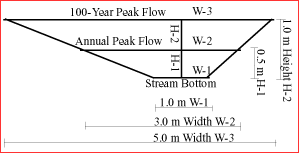| Forest Road Deactivation Practices | |
| in the Pacific Northwest | |
| 21 - Wood Culvert Removal | Sequence of Activities, Peak Flow Estimates |
The removal of all drainage structures must address water quality and slope stability concerns. Operators and supervisors should consult the pre-work checklist to avoid unnecessary delays, negative impacts and unexpected problems. Sediment control is difficult to achieve if the required tools are not at the work site.
If at all practical, it is preferable to work in dry conditions. This can be achieved by scheduling the work during the summer months, or by dewatering the stream. Remember that each stream crossing presents its own challenges. Deactivation specialists, supervisors and operators should discuss available options before work begins.
Be sure to know to what return flood you are managing water flows. Is it the Q-100 flood, i.e., the most amount of water you would expect once in a 100-year period? Ask your supervisor, as this affects the amount of armour required for newly established stream channels.
Figure 20: Typical Stream Cross-Section
The cross-sectional area of a stream during a Q-100 flood is about 3 times bigger than the cross-sectional area of the stream during the annual peak flow. Therefore, estimate the annual high water mark, calculate the annual peak flow cross-section and multiply this area by three. Using the Q-100 peak flow area, you can estimate from that how high armour has to be placed to protect newly established stream channels.
| 21 - Wood Culvert Removal |
| Next |
||
|
|
|
©1999 - 2002 Flip Productions Limited Used with permission by CulvertBC |